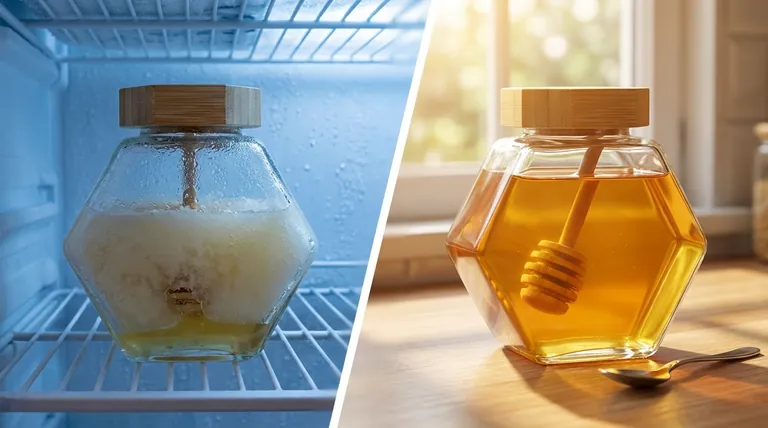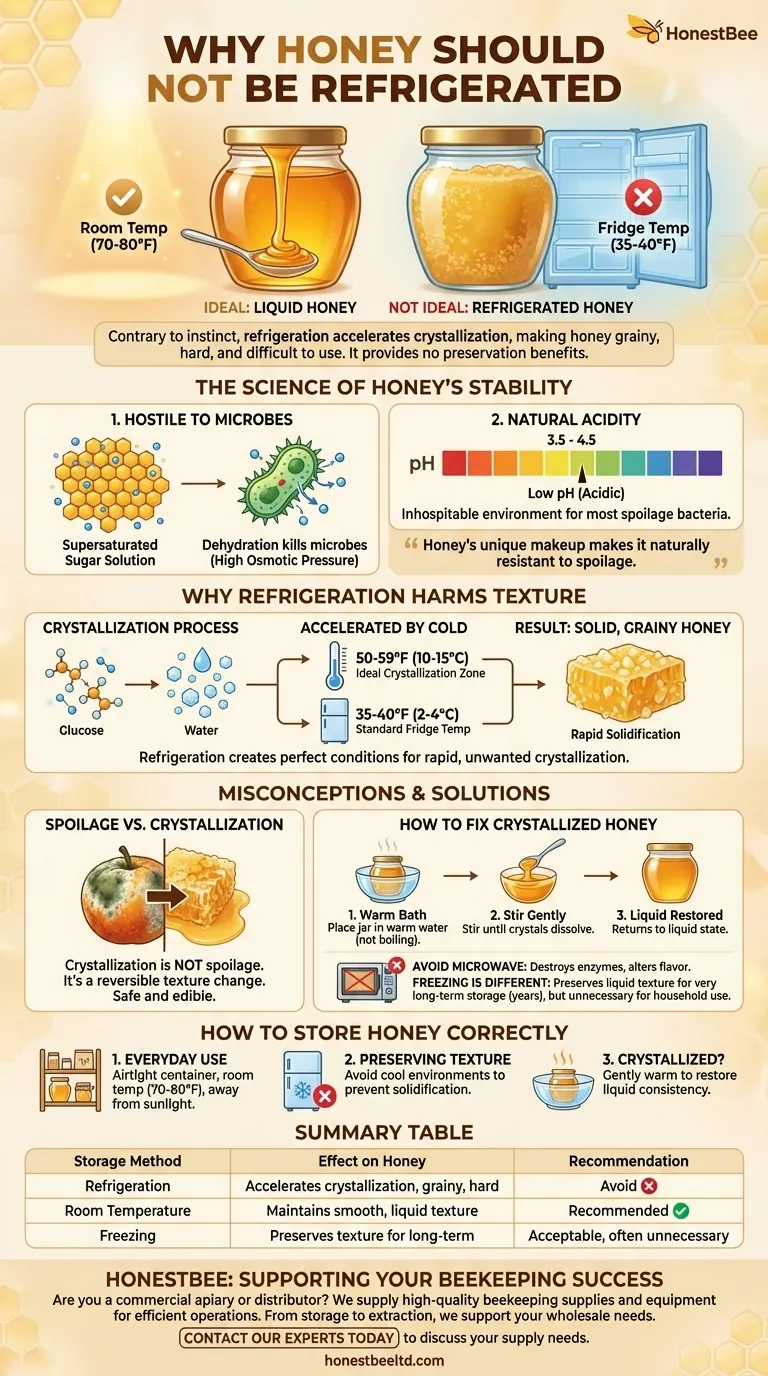Contrary to most food storage instincts, honey should not be refrigerated. Storing honey in the refrigerator accelerates the process of crystallization, causing the glucose to separate from the water and form a thick, semi-solid mass. This doesn't spoil the honey, but it makes it grainy, hard, and extremely difficult to pour or use.
Honey's unique chemical makeup—a supersaturated solution of sugar with very low water content—makes it naturally resistant to spoilage. Refrigeration provides no preservation benefits and only serves to damage its ideal liquid texture.

The Science of Honey's Stability
A Hostile Environment for Microbes
Honey is a supersaturated sugar solution, meaning it contains far more sugar than can normally be dissolved in its small amount of water. This creates an environment of high osmotic pressure.
When bacteria or other microbes land in honey, the water inside their cells is drawn out into the honey, effectively dehydrating and killing them before they can spoil it.
The Role of Natural Acidity
Honey is also naturally acidic, with a pH typically between 3.5 and 4.5. This level of acidity is inhospitable to most of the bacteria and microorganisms that cause food to spoil.
Because of these two properties, honey is one of the most stable natural foods and does not require refrigeration to stay safe.
Why Refrigeration Harms Honey's Texture
The Process of Crystallization
Crystallization is a natural process where the glucose in honey separates from the water and forms tiny crystals. Over time, most pure honey will begin to crystallize.
The speed of this process depends on the honey's specific nectar source and its ratio of glucose to fructose.
How Cold Temperatures Accelerate the Process
The ideal temperature range for honey crystallization is between 50-59°F (10-15°C). A standard refrigerator is kept at around 35-40°F (2-4°C), which falls squarely within the temperature zone that rapidly accelerates this process.
By putting honey in the fridge, you are creating the perfect conditions to turn it from a smooth liquid into a solid, grainy block in a very short amount of time.
Common Misconceptions and Solutions
Spoilage vs. Crystallization
It is critical to understand that crystallization is not a sign of spoilage. The honey is still perfectly safe and edible. It is merely a change in texture.
This change is also completely reversible without damaging the honey.
How to Fix Crystallized Honey
If your honey solidifies, do not discard it. Simply place the jar in a bowl of warm (not boiling) water and stir it occasionally until the crystals dissolve and the honey returns to a liquid state.
Avoid using a microwave, as the intense, uneven heat can overheat the honey, destroying its delicate enzymes and altering its flavor.
Freezing is Not the Same as Refrigerating
While refrigeration is detrimental, freezing is an acceptable method for very long-term storage (multiple years).
Freezing temperatures are too cold for crystals to form, so the honey's liquid texture is preserved. However, for all practical household purposes, this is unnecessary.
How to Store Honey Correctly
To ensure your honey remains smooth and easy to use, follow these simple guidelines based on your goal.
- If your primary focus is everyday use: Keep honey in its original, tightly sealed container at a consistent room temperature (ideally 70-80°F or 21-27°C) and away from direct sunlight.
- If your primary focus is preserving texture: Avoid storing honey in any cool environment, including a cold pantry, basement, or refrigerator, as this will encourage it to solidify.
- If your honey has already crystallized: Gently warm the jar in a bowl of warm water until the crystals dissolve, restoring its liquid consistency.
Properly stored in an airtight container, honey will remain safe and delicious almost indefinitely.
Summary Table:
| Storage Method | Effect on Honey | Recommendation |
|---|---|---|
| Refrigeration | Accelerates crystallization, makes honey grainy and hard | Avoid |
| Room Temperature | Maintains smooth, liquid texture | Recommended |
| Freezing | Preserves texture for very long-term storage | Acceptable, but often unnecessary |
Are you a commercial apiary or beekeeping equipment distributor? Proper honey handling is just one part of successful beekeeping. HONESTBEE supplies the high-quality beekeeping supplies and equipment you need to operate efficiently and profitably. From storage containers to extraction tools, we support your wholesale-focused operations. Contact our experts today to discuss your supply needs and how we can help your business thrive.
Visual Guide

Related Products
- Hexagonal Glass Honey Jar with Wooden Lid Integrated Dipper Elegant Functional Storage
- Classic Beehive Honey Bottle Jar with Squeeze Dispenser Lid
- Inverted Squeezable Honey Jar with No Drip Flip Top Cap for Easy Pouring
- Ergonomic Squeezable Honey Bottle with Precision Twist Nozzle Cap
- Classic Drum Shaped Glass Honey Jar with Airtight Lid
People Also Ask
- How should honeycomb be stored? Preserve Its Delicate Flavor and Texture
- What types of containers are ideal for storing liquid honey? Preserve Quality with Glass or Plastic
- What are the features of honey bottles? Design for Convenience & Long-Term Preservation
- What are the advantages of glass containers for honey packaging? Ensure Purity and Elevate Your Brand
- What types of containers are recommended for storing honey? Preserve Quality with the Right Materials



















